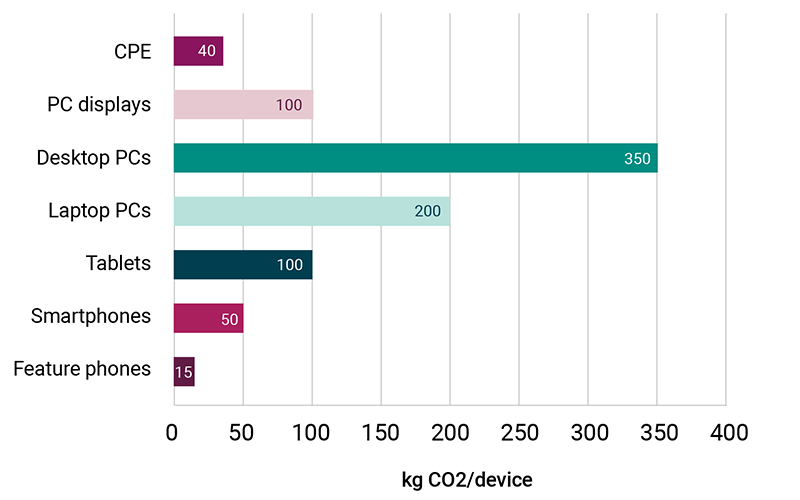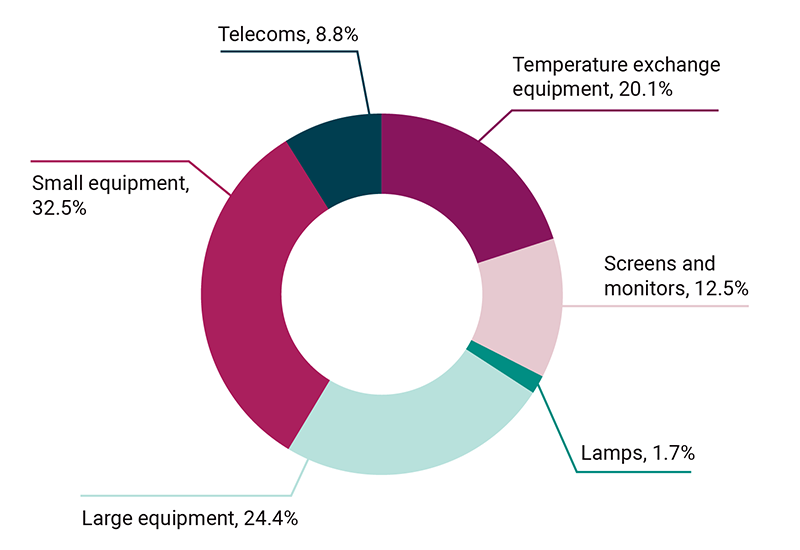Report
Digital sustainability in tertiary education: trends, challenges, and sector insights
Foreword
By Robin Ghurbhurun, UK managing director, further education and skills, nations, advice and training
In our rapidly evolving digital landscape, where technological advancements are reshaping every facet of education, we find ourselves at a pivotal moment where the promise of digital innovation must be aligned with a steadfast commitment to environmental responsibility. This delicate balance underscores the need for informed decision making and proactive measures to mitigate the ecological impact of our digital endeavours.
Amidst these challenges, a beacon of hope emerges. By adopting sustainable procurement practices, implementing energy efficient measures, promoting circular economy initiatives, and establishing effective e-waste management systems, educational institutions can chart a course towards a more sustainable future. Through strong, forward-thinking leadership, and by embracing strategies that nurture a culture of environmental consciousness, we can harness the transformative potential of technology while minimising its ecological footprint.
The following explores the fundamentals of digital sustainability, using both existing literature and direct engagements with our members to identify key trends and challenges within the sector. I commend the authors and researchers who have contributed their expertise to this report, as well as the educators and administrators who are dedicated to driving positive change within their institutions. It is through collaborative efforts and shared vision that we can forge a path towards digital sustainability in education.
As we embark on this collective journey, let us respond to the call for unified action and collaboration and, together, envision a future where education seamlessly integrates digital innovation with environmental stewardship — a future where our commitment to sustainability ensures a brighter tomorrow for generations to come.
Survey methodology
Total respondents: 98
Respondent sector breakdown:
- Higher Education: 65
- Further Education: 27
- Customer: 4
- Research: 2
Solution or pollution?
In an era dominated by technological advances, digital has become an integral and unavoidable part of education. These advances bring rich opportunities as well as challenges for FE and HE institutions, along with important questions around the sustainability of our digital practices. As they continue to integrate digital technologies to enrich education experiences, universities and colleges are often confronted with pressing questions about the long-term viability of their existing digital strategies in relation to their evolving sustainability strategies.
This all poses something of a balancing act: on one hand, digital platforms offer unprecedented opportunities for collaboration, accessibility and personalised learning experiences. On the other, the proliferation of electronic devices, the growing use of data storage and increased energy consumption all raise concerns about the environmental impact of our digital pursuits. Balancing the scales between innovation and sustainability requires a critical examination of the lifecycle of digital resources, the carbon footprint of data centres and the ethical considerations of technology choices.
In response to these challenges, stakeholders in education must engage in dialogue, collaboration and proactive measures to ensure that digital technologies are leveraged responsibly and sustainably. By fostering partnerships between educational institutions, technology providers, policymakers and environmental advocates we can work towards developing and implementing strategies that mitigate the environmental footprint of digital practices while maximising their educational benefits.
This brief report explores some key trends around digital sustainability in tertiary education as well as potential solutions, and it underscores the importance of collective action in shaping a more sustainable future for education and beyond.
The environmental impact of digital technologies
While digitalisation brings numerous benefits to the educational sector, it also comes with a significant environmental footprint across its lifecycle, from production to disposal, cradle to grave. Understanding this impact is crucial for fostering digital sustainability within education institutions.
Cradle: production and device manufacture
The ‘cradle’ phase of digital technologies encompasses the production and manufacturing processes involved in creating devices such as computers, tablets and smartphones, as well as the infrastructure supporting digital services. These processes consume vast amounts of energy and raw materials, leading to greenhouse gas emissions, resource depletion and environmental degradation. Additionally, the extraction of rare earth minerals, often used in electronics manufacturing, contributes to habitat destruction and pollution in mining regions.
Alt text for representative embodied carbon emissions graph
- CPE: 40 kg C02/device
- PC displays: 100 kg C02/device
- Desktop PCs: 350 kg C02/device
- Laptop PCs: 200 kg C02/device
- Tablets: 100 kg C02/device
- Smartphones: 50 kg C02/device
- Feature phones: 15 kg C02/device
- CPE: 40 kg C02/device
- PC displays: 100 kg C02/device
- Desktop PCs: 350 kg C02/device
- Laptop PCs: 200 kg C02/device
- Tablets: 100 kg C02/device
- Smartphones: 50 kg C02/device
- Feature phones: 15 kg C02/device
Use phase: powering devices, cloud and storage emissions
During their lifetime digital devices, data centres and cloud services consume electricity, leading to carbon emissions and environmental strain. Moreover, the ever-increasing demand for data storage and processing contributes to the proliferation of energy-intensive data centres, exacerbating their environmental footprint.
This list includes some examples of sources of greenhouse gas emissions from digital devices and software:
- Device/hardware manufacture
- Device/hardware energy use
- Data centre energy use
- Data centre cooling
- Data transmission
- Software development
- Software use
- Internet infrastructure
- Data storage
- AI training and inference
- Remote working
- Blockchain and cryptocurrency
- Digital content creation
Grave: disposal of end-of-life electrical and electronic equipment
This final phase involves the disposal and end-of-life management of electronic devices, often referred to as ‘waste electrical and electronic equipment’ (WEEE). Improper disposal of e-waste can lead to environmental pollution, soil contamination and health hazards, due to the release of toxic substances like lead, mercury and cadmium.
Alt text for e-waste breakdown graphic
- Telecoms: 8.8%
- Temperature exchange equipment: 20.1%
- Screens and monitors: 12.5%
- Lamps 1.7%
- Large equipment: 24.4%
- Small equipment: 32.5%
- Telecoms: 8.8%
- Temperature exchange equipment: 20.1%
- Screens and monitors: 12.5%
- Lamps 1.7%
- Large equipment: 24.4%
- Small equipment: 32.5%
This examination of the environmental impacts of digital technologies in education shows that these technologies have significant ecological consequences throughout their lifecycle. From the extraction of raw materials for device production to the emission of greenhouse gases during device operation and the disposal of electronic waste, digital technologies pose various environmental challenges that require careful consideration and mitigation strategies.
Digital technologies' environmental benefits
While digital technologies in education bring environmental challenges, they also offer numerous benefits that can contribute to reducing overall environmental impacts within further and higher education institutions.
Reduced paper consumption
One of the most significant environmental benefits for education institutions is the reduction in paper consumption. Digitalisation enables institutions to transition from traditional paper-based processes to electronic alternatives such as e-books, online assignments and digital course materials. By reducing their reliance on paper education providers can conserve natural resources, decrease deforestation and minimise the environmental impact associated with paper production, transportation and disposal.
Energy efficiency and resource conservation
Digital technologies, when used efficiently, can lead to significant energy savings and resource conservation. For instance, virtual learning environments (VLEs) and online collaboration platforms reduce the need for physical classroom spaces, resulting in lower energy consumption for heating, lighting and maintenance. Additionally, digital communication tools enable remote learning and teaching, reducing the need for travel and associated greenhouse gas emissions.
Embracing digital access to educational resources
Digital technologies make it possible for learners to access a vast array of educational resources and learning materials, regardless of their geographical location or physical circumstances. Online libraries, databases and open educational resources (OERs) provide students and educators with access to a wealth of information, reducing the need for printed materials and physical infrastructure. This increased accessibility enhances the educational experience and reduces the environmental footprint associated with resource distribution and storage.
Virtualised administrative processes
Digital technologies can streamline operations and reduce the environmental impact of administrative activities. Digital platforms for registration, enrolment, scheduling and academic record-keeping eliminate the need for paper forms and manual data entry, improve efficiency and help to conserve resources. What’s more, digital communication tools support remote administrative tasks, reducing the need for travel and commuting.
Promotion of sustainable practices
Digital technologies in education provide opportunities for promoting and integrating sustainable practices into curricula and institutional operations. By incorporating environmental education, sustainability initiatives and green computing principles in learning and teaching activities, institutions can raise awareness about environmental issues and empower students to adopt sustainable behaviours. Furthermore, digital sustainability initiatives such as energy-saving campaigns, e-waste recycling programmes and virtual environmental simulations encourage students and staff to participate actively in environmental stewardship.
In short, while digital technologies have some obvious, negative environmental impacts, they offer significant opportunities to mitigate others. By leveraging the benefits of digitalisation, educational institutions can reduce paper consumption, improve energy efficiency, enhance access to educational resources, streamline administrative processes and promote sustainable practices, contributing to environmental conservation and fostering a culture of sustainability and responsibility among students, educators and administrators.
What are institutions doing about digital sustainability?
To get a fuller understanding of the needs and obstacles around digital sustainability activities and provisions, we polled the Jisc member research panel, which includes staff working in both HE and FE. We wanted an overview of how our members across both sectors are managing to navigate this digital sustainability balancing act, and to explore their challenges and successes.
We found that HE institutions were more likely to have official net zero targets in place, while FE institutions were more likely to have sustainable objectives in place, but no formal net zero target. With over two-thirds of survey participants reporting that their organisation had at least some form of objective in place to reduce their environmental impact, environmental sustainability is clearly high on the agenda for both HE and FE organisations.
HE staff perception of their organisation's environmental sustainability objectives
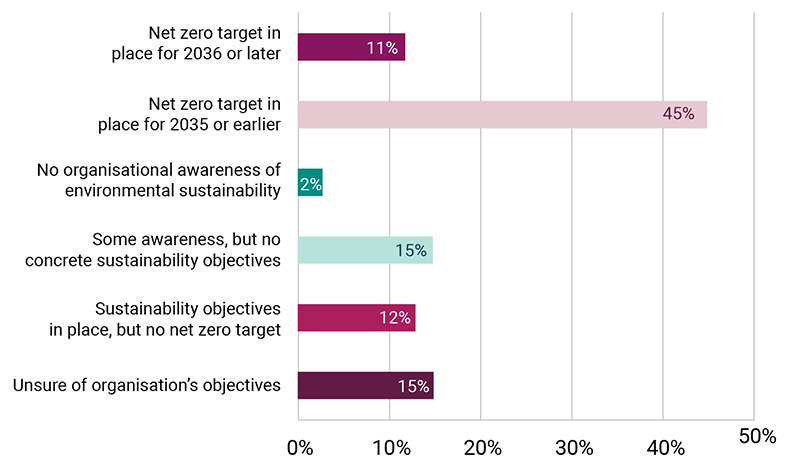
Alt text for HE staff perception of their organisation's environmental sustainability objectives graph
- Net zero target in place for 2036 or later: 11%
- Net zero target in place for 2035 or earlier: 45%
- No organisational awareness of environmental sustainability: 2%
- Some awareness, but no concrete sustainability objectives: 15%
- Sustainability objectives in place, but no net zero target: 12%
- Unsure of organisation's objectives: 15%
- Net zero target in place for 2036 or later: 11%
- Net zero target in place for 2035 or earlier: 45%
- No organisational awareness of environmental sustainability: 2%
- Some awareness, but no concrete sustainability objectives: 15%
- Sustainability objectives in place, but no net zero target: 12%
- Unsure of organisation's objectives: 15%
FE staff perception of their organisation's environmental sustainability objectives
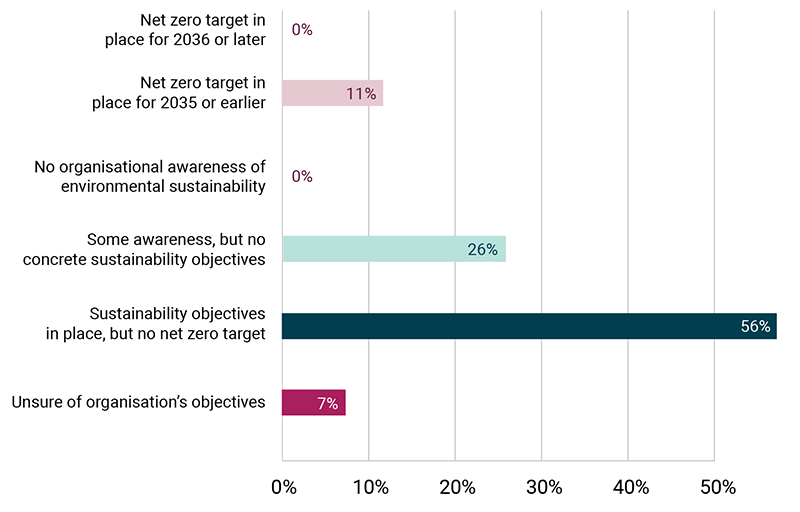
Alt text for FE staff perception of their organisation's environmental sustainability objectives
- Net zero target in place for 2036 or later: 0%
- Net zero target in place for 2035 or earlier: 11%
- No organisational awareness of environmental sustainability: 0%
- Some awareness, but no concrete sustainability objectives: 26%
- Sustainability objectives in place, but no net zero target: 56%
- Unsure of organisation's objectives: 7%
- Net zero target in place for 2036 or later: 0%
- Net zero target in place for 2035 or earlier: 11%
- No organisational awareness of environmental sustainability: 0%
- Some awareness, but no concrete sustainability objectives: 26%
- Sustainability objectives in place, but no net zero target: 56%
- Unsure of organisation's objectives: 7%
In terms of digital sustainability actions already being taken, initiatives around producing guidelines for sustainable procurement and purchasing, as well as having policies and plans in place to maximise the length of time that IT equipment is used before disposal, were among the most commonly reported in both HE and FE.
Actions taken by HE institutions to ensure digital environmental sustainability
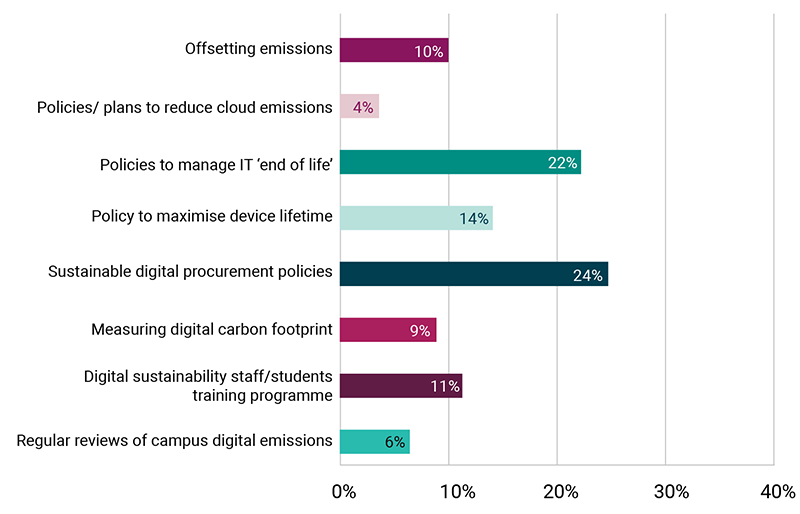
Alt text for actions taken by HE institutions to ensure digital environmental sustainability graph
- Offsetting emissions: 10%
- Policies/plans to reduce cloud emissions: 4%
- Policies to manage IT 'end of life': 22%
- Policy to maximise device lifetime: 14%
- Sustainable digital procurement policies: 24%
- Measuring digital carbon footprint: 9%
- Digital sustainability staff/students training programme: 11%
- Regular reviews of campus digital emissions: 6%
- Offsetting emissions: 10%
- Policies/plans to reduce cloud emissions: 4%
- Policies to manage IT 'end of life': 22%
- Policy to maximise device lifetime: 14%
- Sustainable digital procurement policies: 24%
- Measuring digital carbon footprint: 9%
- Digital sustainability staff/students training programme: 11%
- Regular reviews of campus digital emissions: 6%
Actions taken by FE institutions to ensure digital environmental sustainability
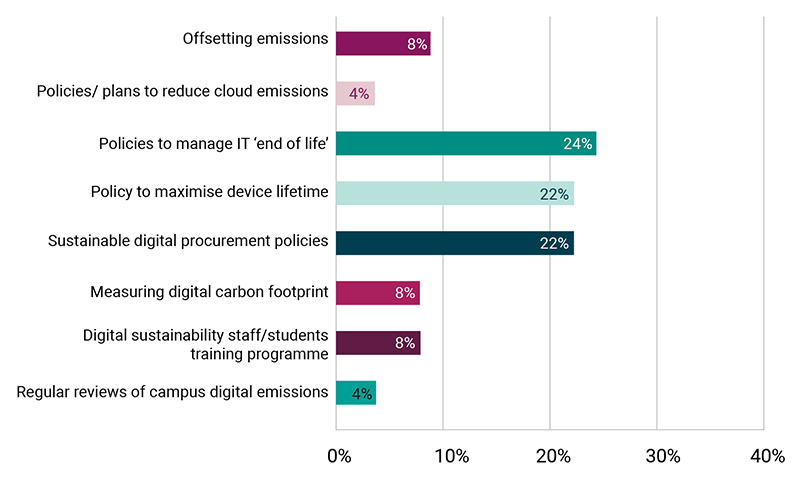
Alt text for actions taken by FE institutions to ensure digital environmental sustainability graph
- Offsetting emissions: 8%
- Policies/plans to reduce cloud emissions: 4%
- Policies to manage IT 'end of life': 24%
- Policy to maximise device lifetime: 12%
- Sustainable digital procurement policies: 22%
- Measuring digital carbon footprint: 8%
- Digital sustainability staff/students training programme: 8%
- Regular reviews of campus digital emissions: 4%
- Offsetting emissions: 8%
- Policies/plans to reduce cloud emissions: 4%
- Policies to manage IT 'end of life': 24%
- Policy to maximise device lifetime: 12%
- Sustainable digital procurement policies: 22%
- Measuring digital carbon footprint: 8%
- Digital sustainability staff/students training programme: 8%
- Regular reviews of campus digital emissions: 4%
Challenges and limitations when adopting digital technologies
The survey also asked HE and FE participants to report what the biggest challenges were in terms of implementing digital sustainability practices across their institutions. The results suggest that influencing staff and student IT use and practices was the greatest issue, followed by monitoring the carbon footprint of their digital practices and reducing greenhouse gas emissions from IT infrastructure and hardware.
Perceived greatest challenges to ensuring digital environmental sustainability in HE
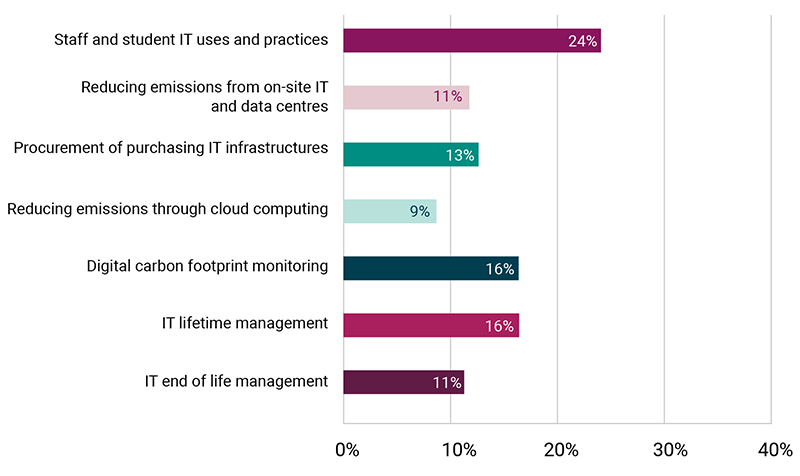
Alt text for perceived greatest challenges to ensuring digital environmental sustainability in HE graph
- Staff and student IT uses and practices: 24%
- Reducing emissions from on-site IT and data centres: 11%
- Procurement of purchasing IT infrastructures: 13%
- Reducing emissions through cloud computing: 9%
- Digital carbon footprint monitoring: 16%
- IT lifetime management: 16%
- IT end of life management: 11%
- Staff and student IT uses and practices: 24%
- Reducing emissions from on-site IT and data centres: 11%
- Procurement of purchasing IT infrastructures: 13%
- Reducing emissions through cloud computing: 9%
- Digital carbon footprint monitoring: 16%
- IT lifetime management: 16%
- IT end of life management: 11%
Perceived greatest challenges to ensuring digital environmental sustainability in FE
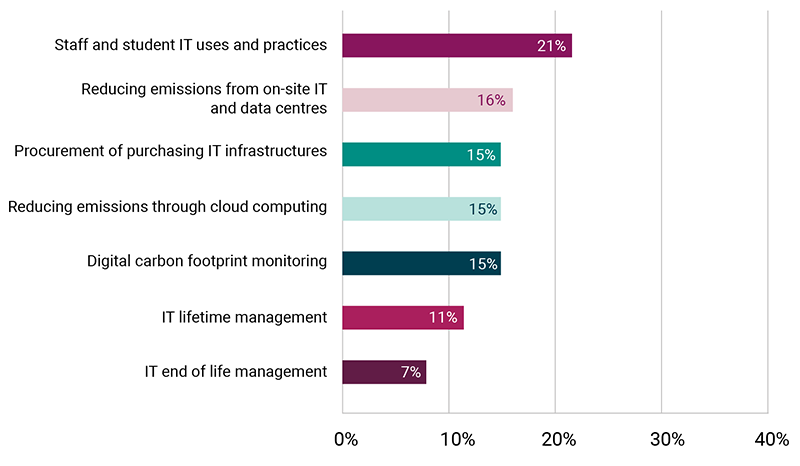
Alt text for perceived greatest challenges to ensuring digital environmental sustainability in FE graph
- Staff and student IT uses and practices: 21%
- Reducing emissions from on-site IT and data centres: 16%
- Procurement of purchasing IT infrastructures: 15%
- Reducing emissions through cloud computing: 15%
- Digital carbon footprint monitoring: 15%
- IT lifetime management: 11%
- IT end of life management: 7%
- Staff and student IT uses and practices: 21%
- Reducing emissions from on-site IT and data centres: 16%
- Procurement of purchasing IT infrastructures: 15%
- Reducing emissions through cloud computing: 15%
- Digital carbon footprint monitoring: 15%
- IT lifetime management: 11%
- IT end of life management: 7%
Eight key digital sustainability needs
Using feedback from our members, we have identified eight key digital sustainability needs that are common across the UK’s HE and FE institutions. The graphic below shows what these are.
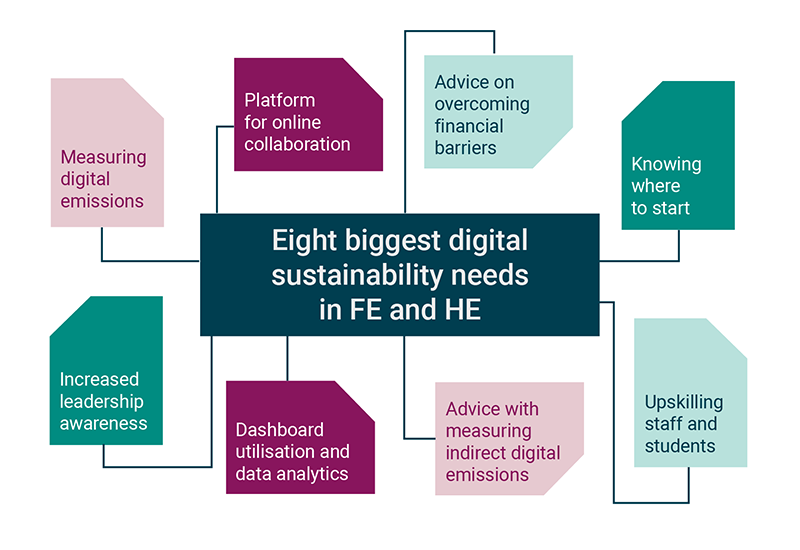
Alt text for eight biggest digital sustainability needs in FE and HE graphic
- Platform for online collaboration
- Advice on overcoming financial barriers
- Knowing where to start
- Upskilling staff and students
- Advice with measuring indirect digital emissions
- Dashboard utilisation and data analytics
- Increased leadership awareness
- Measuring digital emissions
- Platform for online collaboration
- Advice on overcoming financial barriers
- Knowing where to start
- Upskilling staff and students
- Advice with measuring indirect digital emissions
- Dashboard utilisation and data analytics
- Increased leadership awareness
- Measuring digital emissions
We have taken these eight essential requirements, explored the digital sustainability support that is already (or soon to be) available to help in these areas, and shaped some services and solutions of our own to fill the gaps and give the UK’s education providers what they need to both innovate and operate sustainably. We have also developed an implementation road map to show how we will roll these out over the next 12 months.
Jisc’s solutions
Our approach will promote stakeholder awareness of the pressing need for action on digital sustainability. The solutions will create and foster supportive communities and collaborative action, sharing what works and what doesn’t so everyone can make faster and better progress. We will publish thought leadership, advice and guidance on a range of topics, offer training and work with innovators to develop new tools that help institutions measure their carbon footprint and monitor their environmental initiatives.
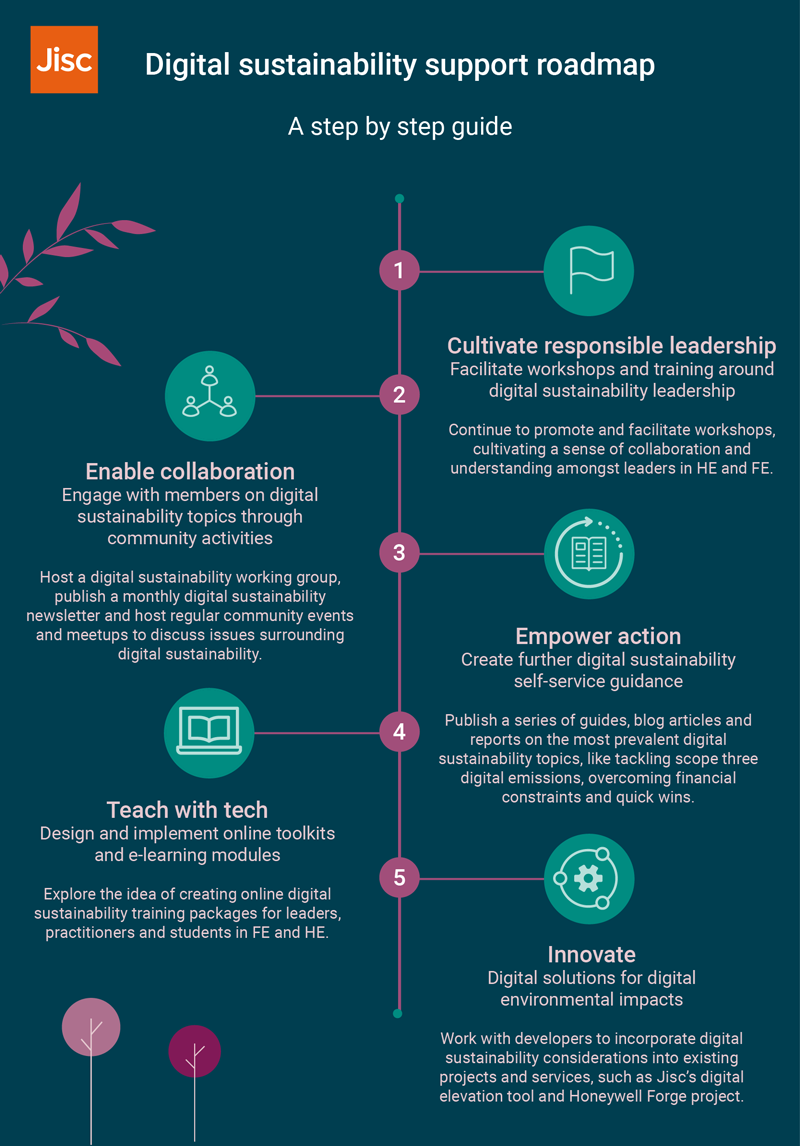
Alt text for digital sustainability support roadmap graphic
A step by step guide
- Cultivate responsible leadership: Facilitate workshops and training around digital sustainability leadership. Continue to promote and facilitate workshops, cultivating a sense of collaboration and understanding amongst leaders in HE and FE.
- Enable collaboration: Engage with members on digital sustainability topics through community activities. Host a digital sustainability working group, publish a monthly digital sustainability newsletter and host regular community events and meetups to discuss issues surrounding digital sustainability.
- Empower action: Create further digital sustainability self-service guidance. Publish a series of guides, blog articles and reports on the most prevalent digital sustainability topics, like tackling scope three digital emissions, overcoming financial constraints and quick wins.
- Teach with tech: Design and implement online toolkits and e-learning modules. Explore the idea of creating online digital sustainability training packages for leaders, practitioners and students in FE and HE.
- Innovate: Digital solutions for digital environmental impacts. Work with developers to incorporate digital sustainability considerations into existing projects and services, such as Jisc's digital elevation tool and Honeywell Forge project.
A step by step guide
- Cultivate responsible leadership: Facilitate workshops and training around digital sustainability leadership. Continue to promote and facilitate workshops, cultivating a sense of collaboration and understanding amongst leaders in HE and FE.
- Enable collaboration: Engage with members on digital sustainability topics through community activities. Host a digital sustainability working group, publish a monthly digital sustainability newsletter and host regular community events and meetups to discuss issues surrounding digital sustainability.
- Empower action: Create further digital sustainability self-service guidance. Publish a series of guides, blog articles and reports on the most prevalent digital sustainability topics, like tackling scope three digital emissions, overcoming financial constraints and quick wins.
- Teach with tech: Design and implement online toolkits and e-learning modules. Explore the idea of creating online digital sustainability training packages for leaders, practitioners and students in FE and HE.
- Innovate: Digital solutions for digital environmental impacts. Work with developers to incorporate digital sustainability considerations into existing projects and services, such as Jisc's digital elevation tool and Honeywell Forge project.
Additional best practices and strategies
While the environmental impacts of digital technologies in education are significant, there are several strategies and solutions that can mitigate these effects and promote digital sustainability within educational institutions.
Sustainable procurement practices
It is essential to implement sustainable procurement practices to reduce the environmental footprint associated with the production and manufacture of digital devices. Education institutions can prioritise the purchase of energy-efficient devices and select suppliers through robust environmental policies. By choosing products with lower energy consumption and sustainable design, institutions can minimise the ecological impact of their purchases.
Energy efficiency measures
Optimising energy efficiency throughout the lifetime (use phase) of digital technologies is critical for reducing electricity consumption and associated carbon emissions. Energy-saving measures include setting devices to power-saving modes, upgrading to energy-efficient equipment and choosing renewable energy sources. Additionally, adopting energy-efficient practices in data centres and cloud services can further reduce the environmental impact of digital operations.
Circular economy initiatives
In a circular economy fewer materials and products go to waste as people and businesses adopt a new mindset: ‘rethink, refuse, reduce, reuse, repair, re-gift, recycle’. Embracing circular economy principles can help extend the lifespan of digital devices and minimise electronic waste generation. Education providers can implement initiatives such as device refurbishment and recycling programmes to promote the reuse and recovery of electronic materials. By adopting circular economy practices institutions can reduce the number of surplus devices in their estate, save money and minimise the environmental impact of digital technologies throughout their lifecycle.
E-waste management
Effective e-waste management is essential for responsibly disposing of outdated electronic devices and preventing environmental pollution. Establishing e-waste recycling programmes or partnering with certified recyclers will ensure the proper disposal and recycling of electronics materials. Educating students, faculty and staff about the importance of e-waste recycling and proper disposal practices can also promote a culture of sustainability within the education community.
Environmental awareness and education
Raising awareness about the environmental impacts of digital technologies and fostering a culture of sustainability will promote responsible use and management of digital resources within educational institutions. Integrating environmental education into curricula, organising awareness campaigns and providing training on sustainable practices can empower students, educators and administrators to make informed decisions and take actions to minimise the ecological footprint of digital technologies.
By implementing these strategies and solutions FE and HE institutions can effectively mitigate the environmental impact of digital technologies and contribute to the advancement of digital sustainability in the education sector.
The need for strong leadership and collaboration
The big, sector-wide environmental challenges require collaborative action from stakeholders across the UK. Achieving meaningful progress towards sustainability depends on collective effort from education institutions, government agencies, technology providers and the broader community.
Multi-stakeholder engagement
Effective collaboration in promoting digital sustainability depends on engaging diverse stakeholders, including education institutions, policymakers, technology vendors, non-profit organisations and community groups. Each stakeholder brings unique perspectives, expertise and resources to the table, making collaborative efforts more comprehensive and impactful. Fostering dialogue and partnerships among stakeholders will make it possible to develop holistic strategies and initiatives that address environmental challenges at various levels.
Knowledge sharing and best practices
Collaboration facilitates the sharing of knowledge, experiences and best practices in digital sustainability across education institutions and sectors. By sharing success stories, lessons learned and innovative solutions institutions can learn from each other and accelerate progress towards sustainability goals. Platforms such as conferences, workshops and online forums provide opportunities for networking, knowledge exchange and collaboration on sustainability initiatives.
Policy alignment and advocacy
Collaborative efforts are essential for advocating for policy reforms and regulatory frameworks that support digital sustainability in education. Institutions can work together to advocate for policies that promote energy efficiency, e-waste management and sustainable procurement practices. By aligning with government agencies and policymakers, stakeholders can influence policy decisions and create an enabling environment for sustainable practices in the education sector.
Industry partnerships and innovation
Collaboration with technology providers and industry partners will drive innovation and help to ensure sustainable solutions are implemented in education. By partnering with companies committed to environmental stewardship, education institutions can access cutting-edge technologies, resources and expertise to support their own sustainability initiatives. Industry-academic collaborations also provide opportunities for research and development of sustainable technologies tailored to the needs of education settings.
Community engagement and empowerment
Beyond institutional boundaries, collaboration can involve the broader community in promoting digital sustainability in education. Engaging students, faculty, staff, parents and local communities fosters a sense of ownership and responsibility for sustainability initiatives. Community-led projects, awareness campaigns and grassroots movements empower individuals to take action and drive positive change in their educational environments.
Global cooperation and partnerships
In an interconnected world, addressing global environmental challenges requires international cooperation and partnerships. Collaborative initiatives such as international research networks, knowledge-sharing platforms and joint projects enable education institutions from different countries to collaborate on sustainability issues. By pooling resources, expertise and experiences global partnerships can lead to innovative solutions and collective action on a global scale.
Conclusion
Digital technologies underpin education delivery, offering almost limitless opportunities for personalised learning, accessibility, resource discovery and collaboration. They also support the efficient day-to-day running of our complex modern education institutions and play a significant role in reducing some aspects of an institution’s environmental impact – cutting down on the use of paper being just one of many.
On the other side of the scale, though, there is the undeniable fact that digital technologies do add to the environmental burden. Manufacturing, using and disposing of electronic devices all come at a cost, and services such as data storage consume large amounts of energy.
HE and FE institutions across the UK have recognised the need to balance their ambitions for constant improvement and digital innovation against the imperative to operate sustainably. Most, if not all, have set themselves environmental targets and developed programmes to help them achieve these. But they face common challenges in achieving them. At Jisc, we believe these big, shared issues require collaborative action and sector-wide approaches.
We are taking a pragmatic approach to bringing institutions together to work on digital sustainability and to develop solutions and services that don’t duplicate what is already out there; instead, we aim to fill the gaps that currently exist so institutions are well supported on their journey to digital sustainability.
Get involved
Find out more about the support we offer for members.
About the author

